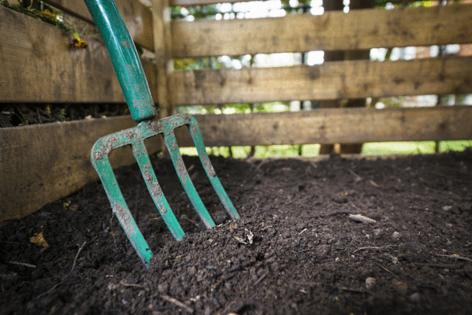How to get better spring veggies through composting in the fall
Published in Variety Menu
PITTSBURGH — If you have a vegetable garden, you might have tried composting. But if you're like me, you may have ended up with a slimy mess — or maybe a pile that just sat there and didn't decompose.
Succeeding at composting can not only benefit your veggies and other plants, but also cut down on your household waste. Yard waste, food scraps and other organic materials make up 34% of municipal waste sent to landfills in Pennsylvania, according to the state Department of Environmental Protection.
Compost is an excellent soil amendment because it is not only filled with nutrients for your plants, but is also bacteria-rich, making it like adding a probiotic to your garden bed.
Fall is an ideal time to start a compost pile, or to try your hand again at composting. There is an abundance of dry leaves as well as organic material from spent garden plants to put into your compost. And with a little tending, you will have it ready in time for your spring plantings.
The basics of composting are not difficult, but even experts say it is a learning process.
Make a good start
In my past attempts at composting, I made a mistake from the very beginning by choosing a plastic composter.
Some experts say that the enclosed plastic containers tend to trap too much moisture, and you sometimes get a sodden mess.
The organic material can start to smell and flies will begin to swarm. Neophytes may throw up their hands and conclude that they don't have the knack.
As an alternative to plastic bins, you can simply make a 3-by-3-foot pile, or create a three-sided bin made of heat-treated wooden pallets. This structure allows air to circulate and the open side enables easy access for turning the pile.
The next step is to add the right materials. A good place to start is a pile of dry leaves or a bale of straw.
Think about "repurposing" your neighbors' dry leaves if they put them out with the trash. Then alternate a layer of dry brown material with green material, like kitchen scraps, making a sort of "lasagna." If you have a hose nearby, wet the pile down as you go.
An approximate ratio of two or three 5-gallon buckets of brown material to one bucket of vegetable scraps will give you a good mix of carbon to nitrogen.
Don't add animal waste, bones, dairy products, weeds with seeds, treated grass clippings or sawdust, because of concerns about disease, chemicals or attracting rodents and other animal pests.
You can finish the pile with a layer of finished compost if it's available. It's like adding a probiotic to the pile, helping it to break down the newer organic material with beneficial bacteria.
If you notice after a while that your compost is too wet, you probably need to add more brown material. If the pile is not decomposing at all, you have too much brown material — wood chips or sawdust.
And — in another mistake that I've made — you do have to turn the pile occasionally with a shovel or pitchfork. If you turn it consistently, you can have finished compost in as little as a month.
Still, you needn't devote all of your spare time to your compost to have good results. Even a pile tended to every few weeks can yield a fertile bonanza.
Pro composting tips
There may be times when you need to ditch your compost and start again.
If it smells bad, with a strong ammonia smell, that means there's not enough oxygen in the system.
Likely, the bacteria in the pile will not be beneficial to plants. What you want to encourage is oxygen-loving bacteria.
If you've created a monstrosity, throw it out and start again. Even expert composters have gone through this experience, I've been assured.
Another thing that has confounded me about composting is that if you're constantly adding new material to the pile and turning it, you will never have that black gold finished compost that you're searching for.
Community gardens often address this by having three wooden bins: one that gardeners actively add to, another that is regularly turned but no new material is added, and a final pile that is finished compost.
To get that final pile, use a homemade sifter made of chicken wire or half-inch hardware cloth stapled to a square of 2-by-4s.
Another pro tip: Use a pair of hand pruners to cut down stalks or other larger pieces of garden waste into 6-inch pieces, which will speed the breakdown of the material.
Using all your senses
Finished compost should be dark and slightly moist, like a wrung-out sponge. It should smell earthy.
Speaking of smells, think about using all of your senses when making compost, like a chef creating a recipe.
How does it smell? What does it look like as it's breaking down? Do you see insects like millipedes, spiders and pill bugs? (This is a good sign, indicating that there is a thriving food chain, including beneficial microbes.) Is the pile hot? (Even in the wintertime, a compost pile may steam.)
By observing, you'll develop a second sense of what your compost needs. You may even want to keep date-stamped photos of your compost to keep track of the stages.
In the spring, add compost to the bottom of holes where you're transplanting seedlings. You can also use it as "top dressing," placing it around the base of a plant.
If this all sounds too complicated, however, there is a simpler, intermediate step.
Create a ring of chicken wire, about a hug's width in diameter, and simply deposit dry leaves in the fall. The leaves will naturally break down and can be used as mulch for your garden, or as a compost starter in the spring.
Composting will benefit not only your plants but the whole tiny ecosystem of insects, worms and microbes in your garden.
____
Grow Pittsburgh has a downloadable PDF available on its website, growpittsburgh.org, as well as a Growers Library with advice for gardeners and urban farmers.
©2025 PG Publishing Co. Visit at post-gazette.com. Distributed by Tribune Content Agency, LLC.










Comments